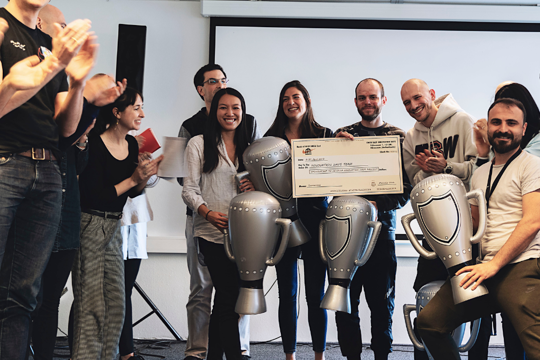
How to break free from groupthink and boost engagement
In this article, you'll learn to avoid meetings dominated by a few loud voices and ensure 100% team engagement by using a simple yet powerful meeting structure inspired by LEGO.
You’ll learn:
-
Why 80% of contributions in meetings often come from just 20% of participants.
-
How LEGO’s meeting strategy helps avoid groupthink and unlocks team creativity.
-
Practical steps to implement this meeting format with or without actual LEGO.
Why your team don't speak up.
Most leaders have experienced the frustration of meetings where only a small percentage of the group actively participates, while the rest of the room stays quiet. It’s common for 80% of the conversation to come from just 20% of the people in the meeting. This means you’re missing out on the valuable perspectives and ideas of the majority of your team.
This dynamic—known as groupthink—happens when the loudest voices dominate the discussion, and quieter team members either agree without contributing or hold back their ideas altogether. Groupthink stifles creativity, limits problem-solving, and results in missed opportunities.
But how can you, as a leader, break this cycle and encourage full participation from everyone in the room?
The answer might surprise you: LEGO. Inspired by LEGO’s meeting strategy in the 1990s, you can use a simple, structured approach to meetings that guarantees 100% participation from your team, ensuring that every voice is heard and the best ideas are uncovered.
The Problem: 80% of Meeting Contributions Come from 20% of the Team
In any given meeting, it’s typical to see a small portion of the participants dominate the discussion. These louder individuals often guide the conversation, unintentionally pushing others into the background. This dynamic isn’t always the result of forcefulness; sometimes it’s simply the natural tendency for more confident or senior team members to speak up first.
However, when the same few people are driving the conversation, you risk missing out on the diverse perspectives and ideas that come from the rest of the group. This dynamic can result in groupthink, where everyone aligns with the dominant voices, even if they have differing opinions or ideas they’re hesitant to share.
The Consequences of Groupthink:
-
Limited creativity: New or innovative ideas are less likely to surface when only a small percentage of the team contributes.
-
Unengaged team members: Those who feel overshadowed in meetings may disengage over time, believing their input isn’t valued.
-
Suboptimal decision-making: Important decisions are made based on a narrow set of perspectives, which can lead to less effective outcomes.
To combat this, you need a structured approach that draws out contributions from everyone and ensures that the quieter, less assertive voices in the room are heard.
LEGO’s Four-Step Meeting Strategy to Avoid Groupthink
LEGO developed a brilliant solution to combat groupthink and encourage full participation in meetings. The approach they took was simple, effective, and highly adaptable, even if you’re not using physical LEGO bricks.
Here’s how LEGO’s four-step meeting process works, and how you can apply it to your own meetings:
Step 1: Ask a Focused Question
At the beginning of the meeting, the leader asks a focused, open-ended question to the group. The question should relate to the core issue you’re addressing, but it must be broad enough to allow for a range of ideas.
For example, if you’re discussing a product development challenge, your question could be, "What are the biggest obstacles our customers face with our current product?"
Step 2: Capture Individual Thoughts in Private
Instead of diving straight into open discussion (where louder voices tend to dominate), each participant is asked to individually capture their thoughts before sharing. In LEGO’s case, they used actual LEGO bricks, asking team members to build models that represented their ideas.
You don’t need to use physical LEGO for this step. You can give each team member a few minutes to write down their thoughts or sketch their ideas on paper. The key here is that each individual has time to think independently, without being influenced by others.
Step 3: Share Responses with the Group
Once everyone has captured their thoughts individually, the next step is for each person to share their response with the group. This can be done round-robin style, where each team member takes a turn presenting their idea or solution.
By giving each person an equal opportunity to speak, you’re ensuring that every voice is heard, and no single idea is overshadowed by louder participants.
Step 4: Reflect on Patterns and Common Themes
After everyone has shared, the group takes time to reflect on the patterns and themes that emerged during the discussion. Rather than immediately jumping into debate or decision-making, the team is asked to look for connections between the ideas and identify any recurring themes or insights.
This reflection stage helps solidify the value of diverse input and encourages the team to think holistically before jumping into solutions. It’s a simple but powerful way to avoid groupthink and ensure that the team is thinking collaboratively.
Why This Meeting Strategy Works
LEGO’s meeting process is effective for several reasons:
1. It Avoids Groupthink by Preserving Independent Thought
When participants capture their thoughts individually before sharing, it prevents the conversation from being dominated by early, loud voices. This ensures that each person’s ideas are formed independently, maintaining the diversity of perspectives that can be lost in unstructured discussions.
2. It Encourages Full Participation
By structuring the meeting so that everyone shares, you’re automatically increasing engagement and participation. No one gets left out, and even quieter or more reserved team members are given a chance to contribute their ideas.
3. It Fosters Reflection and Collaboration
The final step, reflecting on patterns and themes, encourages the team to think as a collective rather than rushing into debate or decision-making. This step helps the group connect ideas and foster a collaborative mindset, rather than focusing on individual opinions or agendas.
4. It Helps Unlock Creativity
Because participants are given time to think independently, they’re more likely to come up with creative and original ideas. Independent thought, combined with structured reflection, can spark new ways of approaching challenges that might not have surfaced in a free-flowing discussion.
How to Adapt LEGO’s Meeting Strategy for Your Team
You don’t need actual LEGO bricks to use this meeting structure (although they could be a fun addition!). Here’s how you can adapt the strategy to your team meetings, even without physical tools:
1. Start with a Focused Question
Begin by asking your team an open-ended question related to the core issue at hand. Make sure the question is focused enough to guide discussion but broad enough to invite diverse perspectives.
2. Encourage Private Reflection
Give your team a few minutes to write down or sketch their ideas independently. You could use index cards, notebooks, or even digital tools like a shared document, where everyone contributes their thoughts in private.
3. Share Ideas in a Round-Robin Style
After private reflection, go around the room (or virtual meeting) and have each person share their response. This ensures everyone contributes and allows for a structured, equal opportunity to present ideas.
4. Reflect on Patterns and Commonalities
Once everyone has shared, guide the group in reflecting on the patterns and themes that emerged. Encourage them to look for connections between the ideas and think about how the insights can shape future decisions or actions.
How you can start applying these ideas
Here’s some practical advice and thought-provoking questions to help you implement LEGO’s meeting strategy and ensure full participation:
1. Start with a Clear Focus:
-
Advice: Ensure your opening question is clear and broad enough to spark diverse ideas. The more focused and thought-provoking the question, the more meaningful the discussion.
-
Thought Starter: What question can I ask that will encourage creative thinking and draw out a variety of perspectives?
2. Prioritize Independent Thought:
-
Advice: Give your team time to think privately before sharing their thoughts. This prevents early voices from dominating and preserves the diversity of ideas.
-
Thought Starter: How can I ensure each person has time to reflect and generate their own ideas before group discussion?
3. Ensure 100% Participation:
-
Advice: Use a round-robin format to give everyone an equal chance to contribute. This guarantees that quieter voices don’t get overshadowed by more vocal participants.
-
Thought Starter: How can I structure meetings to ensure that every voice is heard and valued equally?
4. Encourage Group Reflection:
-
Advice: Take time to reflect on the ideas shared, rather than rushing into debate or decision-making. Look for common themes and insights that might not be immediately obvious.
-
Thought Starter: How can I encourage my team to reflect on patterns and connections, rather than focusing on individual ideas?
Wrap-up: avoid group-think to give everyone access to the best thinking available in the team
By adopting LEGO’s four-step meeting strategy, you can break the cycle of groupthink and ensure that every voice in the room is heard. This structured approach fosters creativity, encourages full participation, and leads to more collaborative and effective decision-making.
CHANGE BY SPRINT VALLEY
Ready for change?
Fast-track ambitious ideas and build a future-ready business your people are proud to be a part of.
